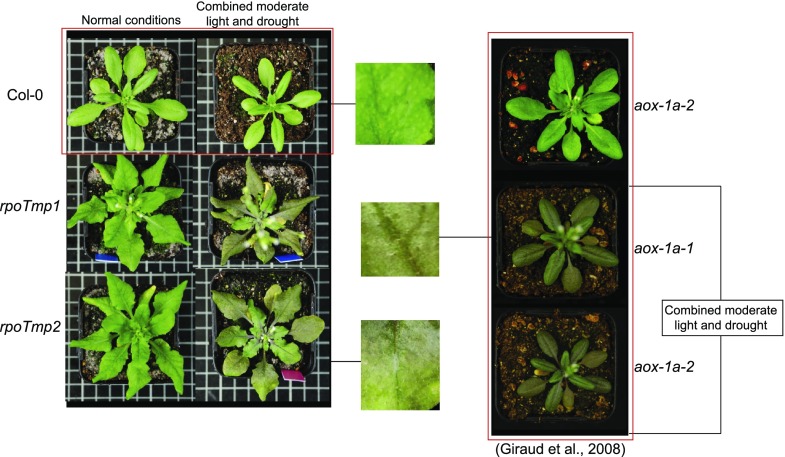Kühn K., Yin G., Duncan O., Law S.R., Kubiszewski-Jakubiak S., Kaur P., Meyer E., Wang Y., Colas des Francs Small C., Giraud E., Narsai R., and Whelan J. Decreasing Electron Flux through the Cytochrome and/or Alternative Respiratory Pathways Triggers Common and Distinct Cellular Responses Dependent on Growth Conditions.
To expose plants to moderate light and drought stress, water was withheld and plants were transferred to 250 μE m−2 s−1. In the Materials and Methods section, the photon flux density was mistakenly listed as 350 μE m−2 s−1 during stress experiments. The corrected portion of the methods paragraph is below. In addition, Figure 1C included an incorrect image for the wild type grown under normal conditions. The authors reassembled a corrected Figure, which is included below. Plant images of the aox1a mutants were intentionally taken from Giraud et al. (2008; Plant Physiology Vol.147: pp 595–610, 2008) for which the microarrays were derived. Both Giraud et al. (2008) and the microarray data (E-ATMX-32) were referenced. This is now indicated in the figure and figure legend. The original results and conclusions of the article are unaffected by this change.
Figure 1.
Effects of inhibition of either complexes I and IV or the AOX on respiration and physiology under normal and stress conditions. A, Respiration capacities were compared between mitochondria isolated from Arabidopsis plants lacking either complexes I and IV (rpoTmp mutants) or the AOX (aox1a mutants) and wild-type plants. Rates of TCA cycle-driven respiration were determined for all mutant lines and the wild type (i and iii). The electron transport capacities of the AOX and the cytochrome oxidase in mitochondrial membranes from rpoTmp and aox1a, respectively, were measured in the presence of AOX- or complex IV-specific substrates and compared with wild-type rates (ii and iv). *, Significant differences. B, In vivo KCN-resistant respiratory rates expressed as a percentage of total respiration in leaf discs under normal growth and MLD (ML+D) conditions. Error bars indicate SE. *, Significant differences. C, Physiological response of Arabidopsis plants to MLD treatment showing increased anthocyanin pigment accumulation after 4 d of treatment in both rpoTmp and aox1a lines compared with wild-type (Col-0) plants. Plants were grown in normal conditions for approximately 4 (Col-0; aox1a) or 5 weeks (rpoTmp) to reach a comparable developmental stage before being transferred to MLD. The aox1a plant images were taken from Giraud et al. (2008).
MATERIALS AND METHODS
Plant Material
Combined light and drought treatments (adverse conditions) were applied as follows: 4-week-old plants (5-week-old rpoTmp mutant lines and 6- to 7-week-old aox1a:rpoTmp) grown under normal conditions with watering every 2 d were either transferred to moderate light conditions (approximately 250 μE m−2 s−1) with no water (starting 4 d before transfer to ensure that soil was dry; MLD) or maintained in normal growth conditions.



